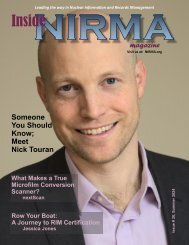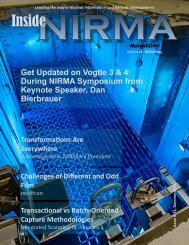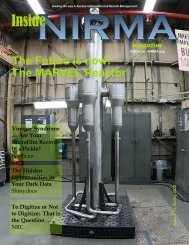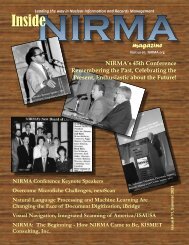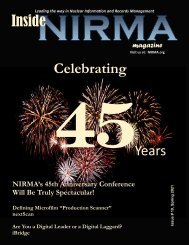Inside NIRMA Fall 2020
Create successful ePaper yourself
Turn your PDF publications into a flip-book with our unique Google optimized e-Paper software.
DOCUMENT<br />
DIGITIZATION<br />
QC<br />
S<br />
ome industries tolerate<br />
Errors and Omissions (EO’s)<br />
in their document digitization<br />
projects more than others. In<br />
fact, some clients irresponsibly assume,<br />
without properly checking, that their<br />
Digitization Service Provider delivered<br />
all records, all meeting the<br />
requirements. Unfortunately, a late<br />
detection may have devastating, often<br />
irreparable consequences.<br />
Clients should demand solid answers<br />
from their providers about how their<br />
QC methodologies apply to the project,<br />
then trust and verify. Answers may<br />
include:<br />
A. Random sampling: Although<br />
essential in most projects for testing<br />
purposes, random sampling<br />
overpromises and under delivers.<br />
B. 100% QC: an elusive,<br />
underestimated notion often<br />
challenging due to time, cost and<br />
other constraints.<br />
C. Counting pages: Partially useful,<br />
but error prone, unreliable.<br />
D. Weak answers signal trouble. If<br />
clients do not act, egg is on their<br />
face.<br />
This article aspires to illustrate some<br />
better answers, and to lay a foundation<br />
for a production model to prevent,<br />
detect, remediate, reduce, trace and<br />
monitor EOs in a document digitization<br />
project.<br />
The basic concept is to identify<br />
critical points where EOs may occur<br />
and establish preventive and corrective<br />
semi-automated methodologies around<br />
certain metrics. By “semi-automated” I<br />
mean a combination of smart<br />
automation and human oversight. I use<br />
methodologies that enable valuable<br />
checks and balances in four workflow<br />
stages:<br />
1. Origination: At the point of<br />
custody acceptance.<br />
2. Production (Physical Context): At<br />
the beginning or end of each task<br />
throughout the production<br />
workflow.<br />
3. Published (Logical Context): When<br />
pages are classified, indexed and<br />
organized as logical documents.<br />
4. Submittal: When deliverables are<br />
subject to final acceptance.<br />
By cross-referencing, comparing and<br />
analyzing aggregate numbers based on<br />
data represented in these four<br />
coordinate systems, EOs become more<br />
conspicuous, allowing for remediation<br />
processes to be effective.<br />
A simplified production workflow<br />
includes many tasks (*), what could<br />
possibly go wrong?:<br />
<br />
<br />
By Manuel Bulwa,<br />
Integrated Scanning of America<br />
www.isausa.com<br />
Some documents may not have<br />
made it entirely through the<br />
production workflow.<br />
Pages can be missed, mutilated,<br />
folded, obstructed, out of sequence,<br />
out of scale, illegible, wrongly split<br />
or merged, overlapped, files may be<br />
corrupted, …<br />
<br />
<br />
<br />
<br />
<br />
<br />
<br />
Page groups can be wrongly<br />
classified, not indexed, duplicated,<br />
“buried”, …<br />
Incorrect, missing or extraneous<br />
document structures.<br />
Incomplete, missing or “made up”<br />
documents, …<br />
Deliverables may be incomplete,<br />
redundant, not fully complying with<br />
SOW, …<br />
Originals may be returned or<br />
disposed of without a valid digital<br />
counterpart.<br />
Originals may not be returned in<br />
full.<br />
Originals may not be returned as<br />
expected.<br />
Other.<br />
What are the causes of EOs?<br />
Each EO is associated to a root cause<br />
(*).<br />
Who is responsible for<br />
consequences?<br />
Both service provider and client have<br />
separate responsibilities(*).<br />
How can EOs be detected and<br />
corrected?: (*)<br />
<br />
<br />
<br />
Planning, testing and training<br />
Timing<br />
Use production level equipment<br />
Continued on next page.<br />
Back to Content | <strong>Inside</strong> <strong>NIRMA</strong> <strong>NIRMA</strong>.org <strong>Fall</strong> <strong>2020</strong> 11



